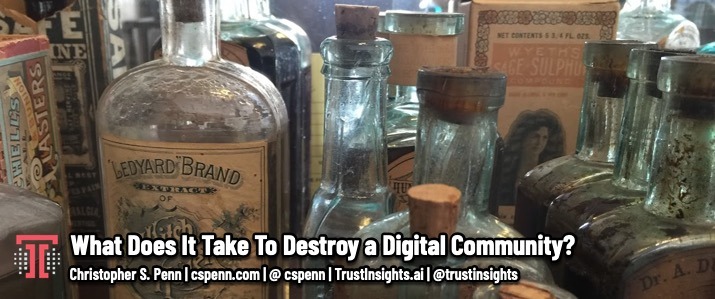
What does it take to kill a community, especially an online one? I’ve been watching a community I’ve been part of slowly fade away, and one of the most striking things about this community’s decline is how little it took to disrupt it. Out of a crowd of almost a thousand, the thing that began the community’s descent was… a single person.
What happened? The community – let’s anonymize it to Digital Cockroach Marketing – started out as a tribe of like-minded folks discussing their favorite subjects. For months, the community grew and grew. Sure, every so often you’d get the inevitable spammer who would join, run in and spam their pitch everywhere, and then be unceremoniously booted out, but that’s par for the course on the Internet.
Digital Cockroach Marketing’s managers, in their best attempts to keep engagement high, would run things like contests, talent showcases, and other fun activities, and for the most part, a decent crowd would participate. Until one day, the community managers decided to start a livestream and made Bob (also anonymized) the host.
There were two problems with this decision. First, Bob was a close friend of the community managers. Second, Bob was a jerk. In a very short period of time, Bob’s new role went to his head and he started offering scathing commentary about other members’ contributions. Bob made sure to only invite the people who were his fans onto the Digital Cockroach Marketing livestream.
Other prominent members of Digital Cockroach Marketing complained to the managers that Bob was acting like a jerk with a superiority complex, but because Bob was friends with them, they didn’t or couldn’t see it. And so, within a month, Digital Cockroach Marketing lost almost a dozen of its highest-profile, most active members. It’s no surprise what happened after – other members who weren’t Bob’s fans became less engaged, and Digital Cockroach Marketing began to wither, transforming into basically the Bob fan club.
What could Digital Cockroach Marketing have done differently? Up until the livestream, most of the decisions about the community were made democratically, with members voting for changes and improvements. I suspect behind the scenes, Bob was the one who lobbied for a livestream to begin with. So, having and enforcing strict policies about how community management worked would probably have slowed the problem.
What wrote the demise of Digital Cockroach Marketing wasn’t an individual decision so much as a series of failures, a governance problem:
First, the community managers didn’t have clear policies on things like favoritism. That alone would have at least made the problem visible sooner. To this day, I’m still not sure Digital Cockroach Marketing’s community managers understand what the problem is, even after a raft of complaints.
Second, Digital Cockroach Marketing didn’t have clear policies on member behavior enforcement. What behaviors are acceptable and unacceptable – and how rigorously are the rules enforced? When a complaint is filed by one member against another, how is the complaint evaluated?
Third, the favoritism problem is one that occurs in many communities. It’s part of who we are as human beings, so we need checks and balances to counteract our natural biases. Digital Cockroach Marketing needed a member-led council specifically dedicated to community rule enforcement, separate from the community managers. That kind of oversight, particularly for larger communities, is essential.
Finally, Digital Cockroach Marketing’s community managers had no analytics or data informing them, else they would have seen a fairly obvious decline in activity over less than a month’s time. That data should have alarmed them, made them ask what was happening that activity, especially among long-time, valued members was down.
Had Digital Cockroach Marketing had any of the above precautions in place, the community managers might have been able to interrupt a significant problem, one that led to the decline of their community and its value to its members and stakeholders.
I’ll leave you with one last thought, especially for digital community managers. Communities, especially online ones, are very fragile constructs. It doesn’t take much to destroy a digital community, just like it doesn’t take much poison to kill you. You don’t need to drink a gallon of cyanide to hurt yourself – a tiny bit will do. And a digital community doesn’t need more than one unchecked bad actor to poison the entire community.
The reasons users tend to join a community – education and connection to others – are found all over the Internet, so if your community suddenly stops providing them, or creates a less hospitable environment, the switching cost to leave your community is low. If you want to keep a community vibrant and alive, you must create and rigorously enforce community standards absent of any kind of bias or favoritism. That’s hard to do – we are all human, and we all have biases towards people we like. But without it, our communities will just be shallow reflections of ourselves at best, and wither away at worst – taking any value the community provided with it.
You might also enjoy:
- Mind Readings: Generative AI and Addition vs Substitution of Jobs
- Fireside Chat: Geraldine Deruiter on Food, Feminism, and Fury
- Almost Timely News, January 28, 2024: Copyright Must NEVER Apply to AI-Made Works
- Almost Timely News, January 7, 2024: Should You Buy a Custom GPT?
- You Ask, I Answer: AI Works And Copyright?
Want to read more like this from Christopher Penn? Get updates here:
 Take my Generative AI for Marketers course! |


Leave a Reply